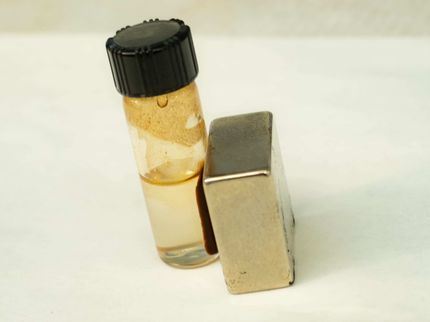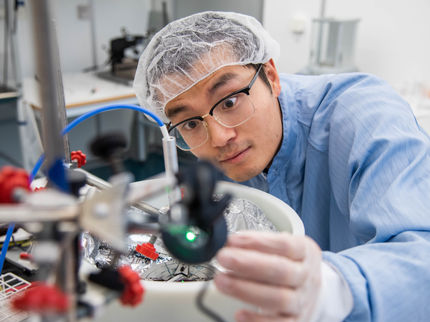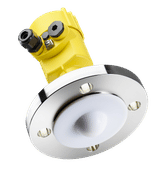Nanoscale, multidimensional artificial magnet created
Applications might range from developing sensors to information encoding.
Advertisement
Scientists from Los Alamos National Laboratory, in collaboration with a group at the University of Illinois at Urbana-Champaign, the Lawrence Berkeley National Laboratory’s Advanced Light Source and with other researchers nationwide, have realized a nanoscale, artificial magnet by arranging an array of magnetic nano-islands along a geometry that is not found in natural magnets.

Researchers have created a nanoscale, artificial magnet by arranging an array of magnetic nano-islands along a geometry that is not found in natural magnets. As temperature is reduced, magnetic nanoislands (in blue) reach a one-dimensional static, ordered state, while those in red keep flipping thermally. The material decomposes into an alternation of ordered/disordered stripes.
Katelyn Gamble, University of Illinois at Urbana-Champaign
“Each nano-island is similar to a refrigerator magnet, with a north and a south pole at its tips,” said Los Alamos physicist Cristiano Nisoli. “Unlike a refrigerator magnet, however, it can change its magnetization by flipping north and south, through use of either applied fields or thermal fluctuations. But because these islands are brought together, they interact, and this interaction induces a collective behavior that can be exploited for emergent properties.”
Applications might range from general magnetism, such as developing sensors, to information encoding.
“This magnet is explicitly designed to exhibit dimensional reduction: in this case going from a two-dimensional behavior to a one-dimensional one,” said Nisoli. “As temperature is lowered to room temperature, the magnet crosses over from being a ‘standard’ magnet into a new and exotic state where it exhibits so called ‘dimensional reduction’ with alternating ordered and disordered stripes, with distinct kinetic behaviors among the two. The ordered stripes are static, while the disordered ones flip thermally.”
Interestingly, the behavior is not random, Nisoli notes, as the stripes and their behavior can be predicted via a 1D Ising model –the very first tool to understand phase transition, which theoretical physicists have been studying for about 80 years—he said.
Multidimensional, flipping nanomagnets, what’s not to love?
Magnetic materials that exhibit exotic/useful behaviors are rare, found by chance in nature, and most of their interesting properties happen at temperatures that are so low as to limit technological applications.
Fabricating magnets with desired properties that are functional at useful temperature ranges is thus relevant for science, technology and national security. “This work belongs to an effort toward bottom-up design of magnets whose desired properties and emergent behaviors can be designed,” Nisoli said.
While this effort has provided a basic science advance by illustrating how emergent behaviors can be explicitly designed into a nanostructure, it can also lead to a material-by-design approach to magnetism that exploits the collective behavior of nano magnets.
A team effort
The project called on the expertise of several science institutions: The geometry of the material was designed and studied at Los Alamos, by Muir Morrison (formerly a Los Alamos student, now a graduate student at Caltech), Tammie Nelson (a Los Alamos Feynman Fellow) and Cristiano Nisoli (a staff member in the Theoretical Division).
The magnet was designed explicitly, along with other geometries, for realization in the context of a longstanding collaboration with the group of Dr. Peter Schiffer (Professor of Physics and Vice Chancellor for Research at the University of Illinois at Urbana-Champaign).
The team nano-fabricated it from samples grown by the group of Prof. Chris Leighton at the University of Minnesota, and they performed the experiment at the Advanced Light Source at Lawrence Berkeley National Laboratory in collaboration with Dr. Andreas Scholl. Funding for the research, including the work led by Schiffer at Illinois, was provided by the US Department of Energy Office of Science. Work performed at the University of Minnesota (UMN) was supported by the National Science Foundation through the UMN MRSEC, as well as by EU Marie Curie IOF project. The Advanced Light Source is a DOE Office of Science User Facility.
Original publication
Other news from the department science
These products might interest you
Most read news
More news from our other portals
See the theme worlds for related content
Topic world Sensor technology
Sensor technology has revolutionized the chemical industry by providing accurate, timely and reliable data across a wide range of processes. From monitoring critical parameters in production lines to early detection of potential malfunctions or hazards, sensors are the silent sentinels that ensure quality, efficiency and safety.

Topic world Sensor technology
Sensor technology has revolutionized the chemical industry by providing accurate, timely and reliable data across a wide range of processes. From monitoring critical parameters in production lines to early detection of potential malfunctions or hazards, sensors are the silent sentinels that ensure quality, efficiency and safety.
































































